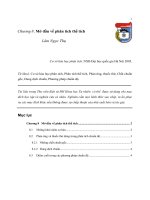Sổ tay hóa học phân tích thực phẩm nước, protein, lipid, carbonhydrat
Bạn đang xem bản rút gọn của tài liệu. Xem và tải ngay bản đầy đủ của tài liệu tại đây (79.01 KB, 2 trang )
BOOKS AND SOFTWARE IN REVIEW
R.E. Wrolstad, T.E. Acree, E.A. Decker, M.H. Penner,
D.S. Reid, S.J. Schwartz, C.F. Shoemaker, D. Smith,
P. Sporns (Eds.): Handbook of food analytical chemistry –
Water, proteins, enzymes, lipids, and carbohydrates
Franz Ulberth
Published online: 21 February 2007
#
Springer-Verlag 2007
Book’s topic The nutritional properties of foodstuffs have
always been an attractive field to chemists and have led to
increased social, economic, and academic interest in food
safety and human well-being. Principles of analytical
chemistry applied to these fields form a basis for gathering
data re garding the composition of food, the effect of
processing on functional and nutritional aspects, and the
occurrence of undesirable substances in food. Analytical
aspects of food chemistr y are not usually covered by
traditional text books, for example H D. Belitz, W. Grosch,
P. Schieb erle: Food Chemistry (3rd edn, 2004) or O.R.
Fennema: Food Chemistry (3rd edn, 1996). Many of the
method descriptions found in peer-reviewed journals lack
the detail which would enable end-users to implement the
methods in their laboratories. The Handbook of Food
Analytical Chemistry tries to fill this niche by providing
detailed instructions and comments for basic and advanced
laboratory techniques in food analytical chemistry.
Contents The book and its companion title Handbook of
Food Analytical Chemistry: Pigments, Colorants, Flavors,
Textures, and Bioactive Food Components, is a compilation
of individual units that were origi nally published in loose-
leaf and CD-ROM format (CurrentProtocolinFood
Analytical Chemistry). It is organized on a disciplinary
rather than a commodity ba sis. Nine units deal with
determination of water including vapour pressure (water
activity) measurements, sixteen units deal with proteins
(measurement of total protein content, purification and
characterization of proteins, functionality of proteins),
seventeen units deal with lipids (extraction and composition
of lipids, lipid oxidation and stability, physical properties),
and ten un its deal with carbohydrates (determination and
characterisation of mono and oligosaccharides, and starch
and cell wall polysaccharides). Units are contributed by
individual authors; all contain, besides description of the
experiments and detailed lists of the chemicals and
solutions required, a commentary section in which back-
ground informatio n, critical conditions, the results
expected, time considerations, literature, and key references
are given. Besides chemic al metho ds of food analysis
important physicochemical testing principles for character-
izing the functionality of proteins (hydrophobicity, water-
retention properties) and the physical properties of lipids
(solid fat content, crystal characterisation, emulsion stabil-
ity) are included.
Anal Bioanal Chem (2007) 387:2603–2604
DOI 10.1007/s00216-007-1138-x
F. Ulberth (*)
European Commission, DG Joint Research Centre,
Institute for Reference Materials and Measurements,
Retieseweg 111,
2440 Geel, Belgium
e-mail:
Bibliography
Handbook of food analytical
chemistry – Water, proteins,
enzymes, lipids, and
carbohydrates
R.E. Wrolstad, T.E. Acree,
E.A. Decker, M.H. Penner,
D.S. Reid, S.J. Schwartz,
C.F. Shoemaker, D. Smith,
P. Sporns (Eds.)
ISBN: 978-0-471-66378-2
Hardcover, 784 pages, 2005,
£94.50/EUR133.40
Comparison with existing literature The content of the
book inevitably overlaps existing collections of methods of
analysis for foodstuffs and feed, which exist either in the
form of handbooks and textbooks or as compilations of
methods issued by professional/trade associations or regu-
latory agencies. Examples of the former category are Food
Analysis, S.S. Nielsen, (Springer, 3rd edition, 2003) and
Handbook of Food Analysis, 3 Volumes, L.M.L. Nollet
(CRC Pr ess, 2nd edition, 2004). Method compilations
issued by AOAC International, the American Oil Chemists’
Society (AOCS), and by national control authorities, for
example the Swiss Food Manual, are examples of the latter
category. I see the added-value of Handbook of Food
Analytical Chemistry as its detailed advisory commentary
and the tips and tricks in the “how to” sections.
Critical assessment Compiling a compendium of food
analytical chemistry is certainly a gargantuan task given the
breadth and depth of the subject. This definitely required
the editors and authors to restrict themselves to certain
topics and to leave others out or mention them only briefly.
Such a selection inevitably bears some subjectivity and
personal preference. To give an example, I would not have
expected to find a quite extensive introduction to circular
dichroism and fluorescence spectroscopy of proteins in this
book, because these topics would seem better placed in
biochemistry textbooks. I did, however, miss a section on
analytical applications of proteins in food chemistry, for
example use of enzymatic test kits for determination of
sugars, acids, etc., and immunological methods (ELISA
procedures), which are nowadays widespread in routine
testing laboratories. Likewise, the so po pular infra-red
analyzers, which are extensively used in the dairy, cereal,
and meat industries to determine protein, fat, moisture, etc.,
are not even mentioned.
Readership recommendation The book is recommendable
to everyone in need of a compendium explaining in detail
the “how to” for a wide variety of basic and some advanced
techniques in a food-analysis laboratory. I would also use it
as a good source of course material for students, to intro-
duce them to principles of chemical analysis of foodstuffs.
Summary Handbook of Food Analytical Chemistry – Water,
Proteins, Enzymes, Lipids, and Carbohydrates gives a good
overview of the principles of analysis of these important
components of food. Advisory comments and recommen-
dations how to carry out the test instructions, which are
normally not found in other sources, make the compendium
particularly valuable.
2604 Anal Bioanal Chem (2007) 387:2603–2604









